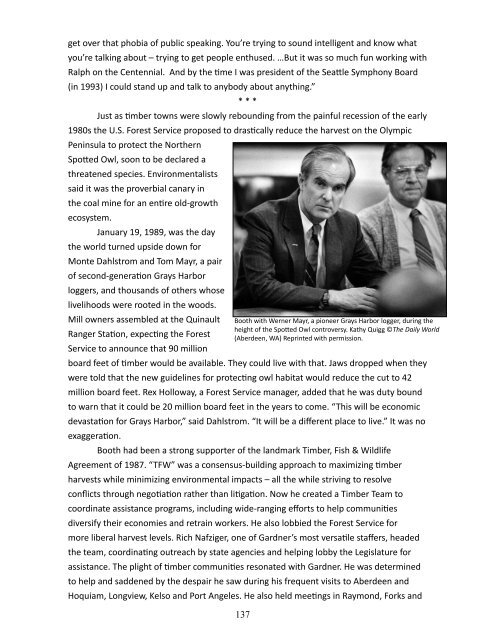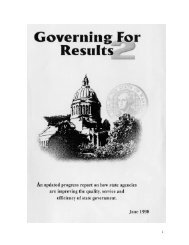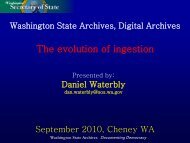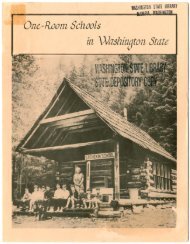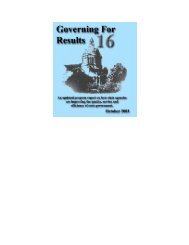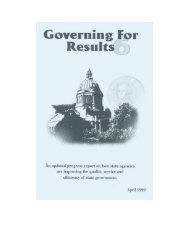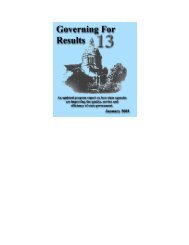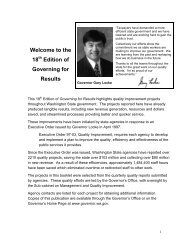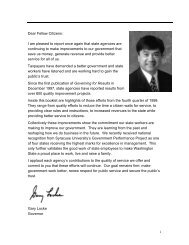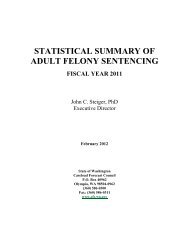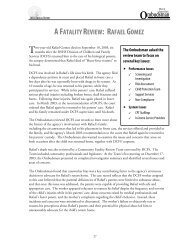BOOTH WHO? - Washington State Digital Archives
BOOTH WHO? - Washington State Digital Archives
BOOTH WHO? - Washington State Digital Archives
You also want an ePaper? Increase the reach of your titles
YUMPU automatically turns print PDFs into web optimized ePapers that Google loves.
get over that phobia of public speaking. You’re trying to sound intelligent and know what<br />
you’re talking about – trying to get people enthused. …But it was so much fun working with<br />
Ralph on the Centennial. And by the time I was president of the Seattle Symphony Board<br />
(in 1993) I could stand up and talk to anybody about anything.”<br />
* * *<br />
Just as timber towns were slowly rebounding from the painful recession of the early<br />
1980s the U.S. Forest Service proposed to drastically reduce the harvest on the Olympic<br />
Peninsula to protect the Northern<br />
Spotted Owl, soon to be declared a<br />
threatened species. Environmentalists<br />
said it was the proverbial canary in<br />
the coal mine for an entire old-growth<br />
ecosystem.<br />
January 19, 1989, was the day<br />
the world turned upside down for<br />
Monte Dahlstrom and Tom Mayr, a pair<br />
of second-generation Grays Harbor<br />
loggers, and thousands of others whose<br />
livelihoods were rooted in the woods.<br />
Mill owners assembled at the Quinault<br />
Ranger Station, expecting the Forest<br />
Service to announce that 90 million<br />
board feet of timber would be available. They could live with that. Jaws dropped when they<br />
were told that the new guidelines for protecting owl habitat would reduce the cut to 42<br />
million board feet. Rex Holloway, a Forest Service manager, added that he was duty bound<br />
to warn that it could be 20 million board feet in the years to come. “This will be economic<br />
devastation for Grays Harbor,” said Dahlstrom. “It will be a different place to live.” It was no<br />
exaggeration.<br />
Booth had been a strong supporter of the landmark Timber, Fish & Wildlife<br />
Agreement of 1987. “TFW” was a consensus-building approach to maximizing timber<br />
harvests while minimizing environmental impacts – all the while striving to resolve<br />
conflicts through negotiation rather than litigation. Now he created a Timber Team to<br />
coordinate assistance programs, including wide-ranging efforts to help communities<br />
diversify their economies and retrain workers. He also lobbied the Forest Service for<br />
more liberal harvest levels. Rich Nafziger, one of Gardner’s most versatile staffers, headed<br />
the team, coordinating outreach by state agencies and helping lobby the Legislature for<br />
assistance. The plight of timber communities resonated with Gardner. He was determined<br />
to help and saddened by the despair he saw during his frequent visits to Aberdeen and<br />
Hoquiam, Longview, Kelso and Port Angeles. He also held meetings in Raymond, Forks and<br />
Booth with Werner Mayr, a pioneer Grays Harbor logger, during the<br />
height of the Spotted Owl controversy. Kathy Quigg ©The Daily World<br />
(Aberdeen, WA) Reprinted with permission.<br />
137


